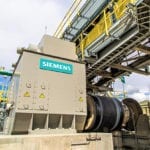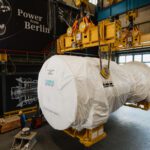Siemens will spin off and give up its majority stake in its lucrative Gas and Power division—comprising its conventional power generation, power transmission, oil and gas, and related services businesses—and transfer its current majority 59% stake in Siemens Gamesa Renewable Energy (SGRE) to the new business.
The company’s supervisory board announced the spinoff on May 7 as part of its Vision 2020+ strategy concept. The board said the move would help Germany-based Siemens meet medium-term growth and profit targets by “clearly focusing its portfolio on dynamic growth markets and efficiency gains.” Siemens is set to announce its quarterly earnings on May 8. The company’s stock price has risen about 5% this year.
The Gas and Power spinoff and transfer of SGRE stake would create a new “major player on the energy market” with a business volume of €30 billion and more than 80,000 employees, Siemens said. The carveout will give the new company “complete independence and entrepreneurial freedom,” it said. Siemens said the new company will have a stock exchange listing by September 2020.
The Gas and Power unit had sales of 12.4 billion euros ($13.8 billion) in 2018, and 377 million euros ($421 million) in profit. Profitably has fallen year-over-year in recent years due to growth in renewable power generation and decreased sales of Siemens’ gas turbines and other power plant equipment.
Siemens, which employed 379,000 workers worldwide at the end of 2018, including about 44,000 in its Gas and Power unit, said it will create 25,000 new jobs in digital industries and smart infrastructure, including electric mobility, energy storage, and smart buildings, though job cuts in other areas will reduce the net number of new jobs to about 10,000. The company wants to cut about $2.5 billion in costs by 2023.
The move will create a “powerful pure play in the energy and electricity sector with a unique, integrated setup – an enterprise that encompasses the entire scope of the energy market like no other company,” explained Joe Kaeser, president and CEO of Siemens AG. “Combining our portfolio for conventional power generation with power supply from renewable energies will enable us to fully meet customer demand. It will also allow us to provide an optimized and, when necessary, combined range of offerings from a single source.”
The news is a stunning move for a company that has been a crucial player in the power sector since its inception 150 years ago. The decision about the spinoff and public listing still need to be cemented, likely at a special shareholder’s meeting in June 2020.
While Siemens will give up its majority stake in Gas and Power, it also said it would remain a “strong anchor shareholder in the new company, with a stake that is to be initially somewhat less than 50% and, for the foreseeable future, above the level of a blocking minority holding,” it said. Siemens also plans to support the new company through its professional financial services and its regional sales networks, as well as through “the licensing of the powerful Siemens brand.”
The spinoff will put Siemens’ Digital Industries (DI) and Smart Infrastructure (SI) divisions as its core. “This core will be supplemented by company-wide technology and service units and the company’s strategic majority stake in Siemens Healthineers. Siemens Mobility is also to be further strengthened as a growth business,” the company said.
According to Kaeser, Siemens is convinced that the strategic spinoff decision “will be positive for all participants and enable long-term value creation for customers, employees and shareholders.” The company also plans to “jointly pursue” recent market successes, such as its significant $15 billion deal in Iraq.
Lisa Davis, who heads Siemens’ Gas and Power division, said in a statement that independence of the new company—which she will lead until October 2021—would help it “more effectively leverage our position of strength to further support our customers in rapidly changing energy markets.”
Davis noted the “freedom and agility” to concentrate on “highly specific and quickly changing requirements” of changing markets and customers was becoming especially important. “In addition, we’ll be able to more directly control our costs and ensure that our stakeholders benefit directly from every euro we spend,” she said.
Siemens and other power sector giants, including General Electric (GE) and Mitsubishi Hitachi Power Systems (MHPS), have struggled in recent years with sagging demand for gas turbines, which have been a core part of their business. Growth in renewable energy has led to declining revenue for the companies, resulting in thousands of layoffs—GE cut 12,000 jobs in its Power division—and also talk of consolidation.
GE’s cuts announced in 2017 came just weeks after Siemens said it would cut 6,900 jobs, mostly in its power and gas sector.
—Sonal Patel and Darrell Proctor are POWER associate editors (@POWERmagazine).










